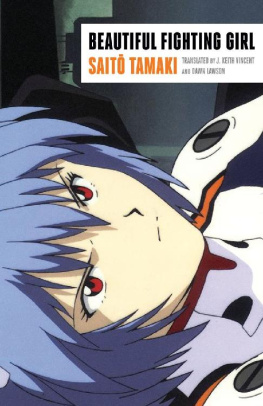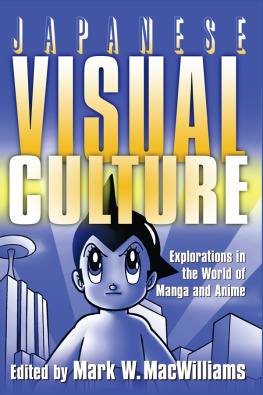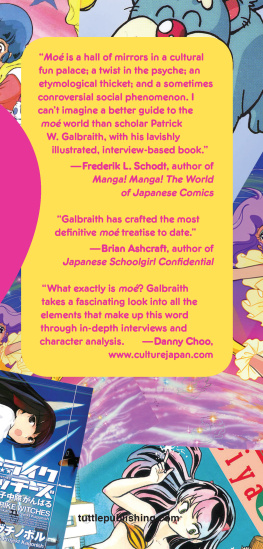
BEAUTIFUL FIGHTING GIRL
This page intentionally left blank
Fu
BEAUTIFUL FIGHTING GIRL
SAITO TAMAKI
Translated by J. Keith Vincent and Dawn Lawson Commentary by Hiroki Azuma
Converted to Epub for the fuckfaces at /lit/
University of Minnesota Press
Minneapolis
London
CONTENTS
A Note on the Translation vii
Translators Introduction Making It Real: Fiction, Desire, and the Queerness of the Beautiful Fighting Girl ix J. Keith Vincent
BEAUTIFUL FIGHTING GIRL
Preface
The Psychopathology of the Otaku
Letter from an Otaku
Beautiful Fighting Girls outside Japan
The Strange Kingdom of Henry Darger
The Emergence of the Phallic Girls
Commentary The Elder Sister of Otaku:
Japan's Database Animals 181 Hiroki Azuma
Notes Index
This page intentionally left blank
A NOTE ON THE TRANSLATION
A cotranslation can be approached in several ways. For this project, each of us did an initial translation of three of the books six chapters. Then we checked each others work against the Japanese, exchanging queries about meaning and English word choices. We both take full responsibility for any errors that may have crept in during the process.
For the romanization of Japanese words, we used the modified Hepburn system (i.e., the system in the third and later editions of Kenkyushas New Japanese-English Dictionary ). Japanese names are given in Japanese order, family name first; for example, Saito Tamaki. When a manga or anime has appeared in English or has an established English equivalent for its title, that English title is given first, with the Japanese title in parentheses the first time that title appears in a chapter. References used as sources for English titles are listed in the notes. When there is no established English equivalent, the Japanese title is used, with an English translation in parentheses at first mention in a chapter. Macrons mark long vowels in Japanese, except on common words such as Tokyo and Osaka Unless otherwise noted, all Japanese references were published in Tokyo.
The translators thank Jason Weidemann at the University of Minnesota Press for his guidance throughout the publication process and Jonathan Abel for his helpful comments on the manuscript. Finally, we thank our partners, Anthony and Alan, for their understanding and patience while this baggy monster dominated our waking hours.
This page intentionally left blank
TRANSLATOR'S INTRODUCTION
Making It Real: Fiction. Desire, and the Queerness of the Beautiful Fighting Girl
J. KEITH VINCENT
As anyone with even a passing familiarity with Japanese popular culture can attest, the fictional worlds of anime and manga are teeming with pre- pubescent girls fighting to save the world. Sometimes overtly sexualized, always intensely cute, and often a mixture of both, the beautiful fighting girl in all her many guises has acquired superstar status in the Japanese cultural imagination. Sailor Moon, Nausicaa, Kiki, Princess Knight: the list goes on and on. Saito Tamakis book Beautiful Fighting Girl asks what the emergence and proliferation of this iconic figure can tell us about the genres of anime and manga in which she appears, about the sexuality of those who produce and consume her, and about the shifting borders between reality and fiction in an image-soaked world.
Most analyses of the beautiful fighting girl tend to conform to one of two perspectives. For some critics, her emergence is a welcome sign of female empowerment, or at least a Japanese version of girl power . As Susan Napier writes in her exhaustive account of Japanese anime, series such as Cutey Honey and Sailor Moon, both of which fall under Saitos definition of the beautiful fighting girl genre,
show images of powerful women (albeit highly sexualized in the case of Cutey Honey ) that anticipate genuine, although small, changes in women's empowerment over the last two decades and certainly suggest alternatives to the notion of Japanese women as passive and domesticated.
Spunky girl superheroes are surely preferable to damsels in distress. But as the creeping qualifiers in Napiers prose (albeit highly sexualized, anticipate, genuine, although small) suggest, the beautiful fighting girl
is not an unambiguous icon of feminist empowerment. Napiers slight discomfort turns to outright hostility in other critics, for whom the beautiful fighting girls hypersexualized and borderline pedophilic image is a symptom of precisely the opposite: the continuing objectification and infantilization of women in Japanese society . This polarization of attitudes toward her is perhaps the beautiful fighting girls most definitive characteristic. As Anne Allison writes in a masterful account of the phenomenon that is Sailor Moon, This fable of fierce flesh, as I call itgirls who show off their bodies yet are fierce fighters just like male superheroesdefies easy categorization as either (or simply) a feminist or sexist script .
No doubt a large part of what makes the beautiful fighting girl so difficult to categorize has to do with how she confounds certain mimetic understandings of cultural production that underpin both the feminist and the sexist interpretations. Both assume, in other words, that she is in some sense a reflection of the status of girls and women in Japan. Studying the beautiful fighting girl, then, is understood as a way to get at the reality of womens lives in the culture that produced her. What these analyses often miss, however, is that the beautiful fighting girl is also a fictional creature in her own right, and one capable of fulfilling functions other than straightforward representation. She is inscribed, moreover, within certain generic parameters and flourishes only in certain media, specifically those of anime and manga, and more recently computer games. If she were simply a representation of a certain social reality or ideology (be it feminist, misogynist, or otherwise), we would expect to find her in all sorts of media, including not only anime and manga but also novels, films, and theater. But just as the final female is inherently tied to the horror genre or the femme fatale to noir, the beautiful fighting girl is most at home in the drawn worlds of anime and manga. Why is that? What is the special affinity between the beautiful fighting girl and these media forms? What does she have to tell us about the psychic space of contemporary Japanese popular culture? If there is more to her than what one critic has called "a mirror of girls dreams, is there someone else whose dreams she might reflect ?
As a practicing psychiatrist in the Lacanian tradition with a keen interest in media culture, Saito Tamaki was uniquely positioned to tackle these questions when he wrote Beautiful Fighting Girl more than a decade ago, and his ideas are still reverberating among cultural theorists in Japan today Saito reads the beautiful fighting girl not as a reflection
X
TRANSLATOR'S INTRODUCTION
of the status or the desires of women but as an autonomous object of desire, an imaginary phallic girl whose unbridled jouissance lends reality to the fictional spaces she inhabits. Saito reconstructs her origins in the pleasurable but disorienting experience of being sexually aroused by a drawn image of a beautiful girl with no referent in reality He locates this primal scene in the childhood of the pioneering anime director Miyazaki Hayao, the creator of works like Nausicad of the Valley of the Wind, Princess Mononoke, and Kiki's Delivery Service, all of which feature beautiful fighting girls . Miyazaki has said that he was first inspired to make anime by the film Panda and the Magic Serpent (Hakuja den, 1958), Japans first color feature-length anime, and Saito hypothesizes that the young Miyazaki was caught off guard by a sexual attraction to the films heroine. The girl (actually the spirit of a white serpent named Bai-Niang) was an impossible object, a fictional creature who therefore contained already within her the occasion for lossyet Miyazaki desired her. This experience of being made to experience pleasure against his will by a fictional construct constituted a trauma for Miyazaki. Because unresolved traumas can only be repeated, for Miyazaki this meant the creation of a whole string of beautiful fighting girls in his own works. While Miyazaki tends to insist on the wholesomeness of his works and to disavow any sexual component, in Saitos analysis the appeal of Miyazakis beautiful fighting girls has everything to do with sexuality. Insofar as their repetition perpetuates a libidinal attachment to a fictional construct, they also challenge us to rethink our understanding of the ontological status of fiction in the visual register.












